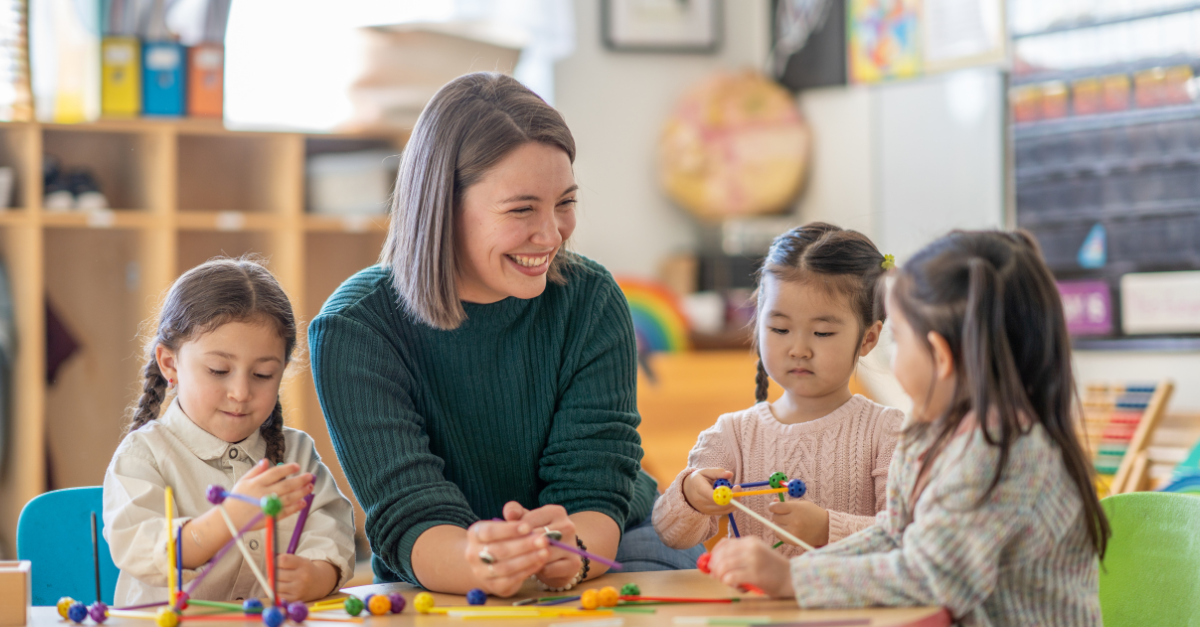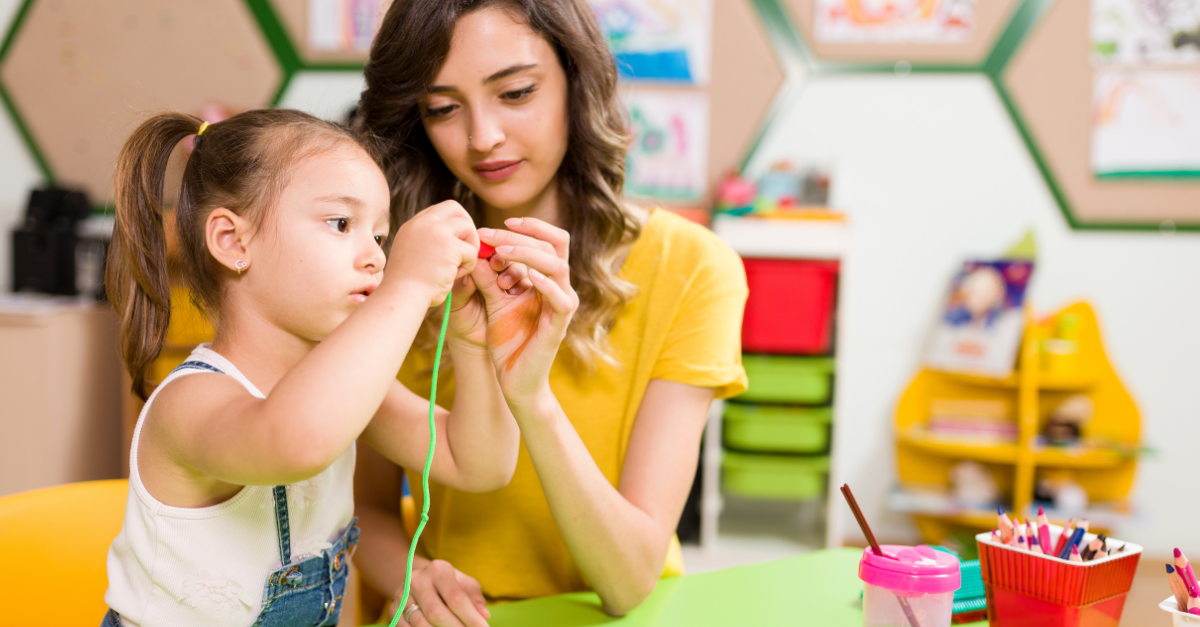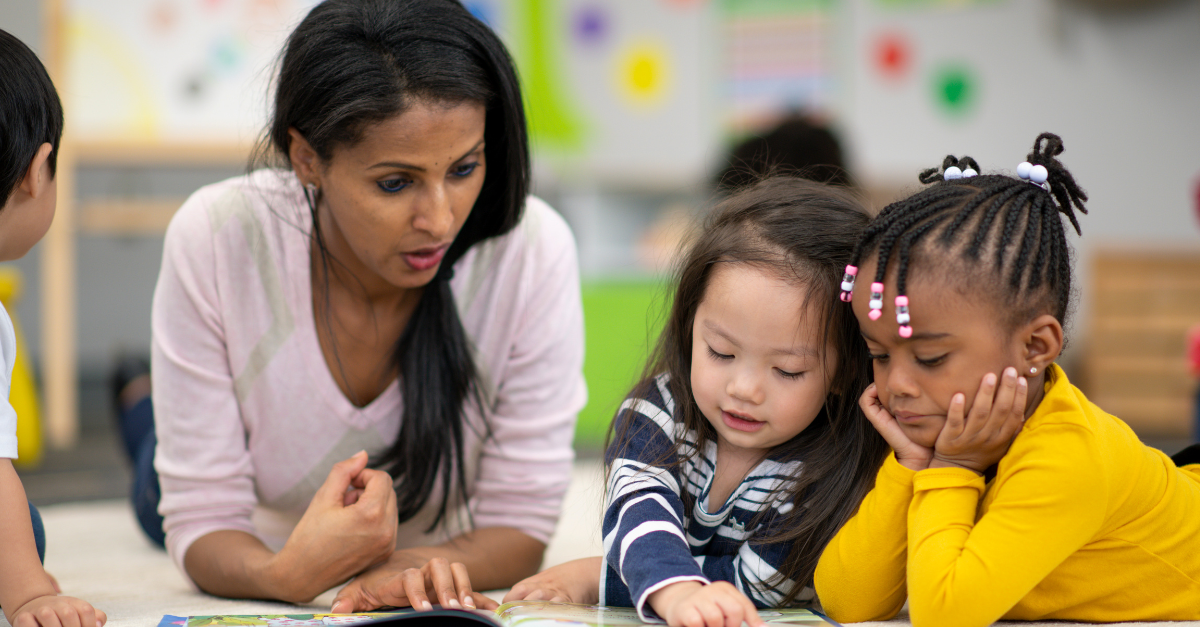Positive relationships between caregiver and child in early childhood education are the cornerstone of a quality learning environment. It is the quality of these relationships that not only sets the foundation for a healthy social-emotional development and overall well-being in early childhood, but also creates a space where children feel accepted, safe and loved.
It is through positive and healthy relationships that children begin to discover who they are, and understand themselves in relation to others. Since many young children in child care spend the majority of their week with their early childhood educators, the quality of these relationships is critical.

Positive relationships encompass building a strong emotional connection built on safety, trust and understanding. When young children feel safe, seen and valued, they are more likely to take chances, express themselves and embrace the learning environment with confidence and enthusiasm.
In this article, we’ll explore five strategies for nurturing positive relationships with children and the impact of professional development in early childhood education.
Understanding the importance of positive relationships
Research consistently shows that children who have supportive relationships with their child care providers demonstrate better emotional regulation, higher self-esteem, and improved social skills. These relationships create a sense of safety and trust, enabling children to explore, learn, and develop to their fullest potential.

Strategy 1: Establishing trust and safety
Building trust is fundamental in any relationship, and it’s especially critical when working in early education. Trust forms the foundation upon which positive relationships are built. To establish trust, we need to create a safe and nurturing environment where children feel valued and respected. Consistency is key; be reliable in your interactions and follow through on promises. Children learn from how you respond and interact with them. Show them that their feelings are valid, their needs are taken seriously and that you will advocate for them whenever needed.
Classroom tips for building trust
Create predictable routines: Consistent routines provide a sense of security for children. Establish daily rituals such as morning greetings, circle time, and classroom expectations. Predictable routines help children feel secure and confident in their environment. Children also start to build more trust when they see the adults in their lives follow through with expectations and help them feel secure.
Active listening: Pay close attention to children’s thoughts, feelings, and concerns. Show empathy and validate their emotions. When children feel heard and understood, they are more likely to trust and confide in you. It also teaches them that their feelings matter, which is critical in helping them build confidence, self-awareness and empathy.
Check out Lillio’s professional development webinar on validating children’s emotions in the early years!
Set clear boundaries: Boundaries provide structure and help children understand expectations, they also help children to feel safe. Always follow through, but remain gentle in enforcing rules, and always explain the reasons behind them. Consistent boundaries create a sense of safety and security.
Make time to be present. When possible, make time for unstructured and dedicated time with children. Being present and by their side while they explore, showing sincere interest and waiting for an invitation to play with them. This demonstrates your commitment to them and let them know that they are worthy of your time.

Strategy 2: Positive and empathetic communication
Effective communication is at the heart of building positive relationships with children. Through meaningful interactions, we can connect with children on a deeper level.
To have authentic communication with young children, it is important to speak to them from a place of respect. Meaning we see them as the competent and capable humans they are, and we create a safe space for them to feel their emotions and be part of daily conversations and decisions.
Use positive language: Encourage children with affirming statements and praise their efforts. Positive reinforcement builds confidence and self-esteem. Instead of focusing on mistakes, highlight what they’ve done well.
Encourage open dialogue: Create an environment where children feel comfortable expressing their thoughts and feelings. Encourage questions and discussions, and validate diverse perspectives. Open communication fosters trust and strengthens relationships.
Nonverbal Communication: Pay attention to your body language, facial expressions, and tone of voice. Nonverbal cues convey messages that are just as important as words. Maintain eye contact and use a gentle tone to convey warmth and approachability. This is especially critical for any child care professional working with infants and non-verbal children.

Strategy 3: Embracing individuality and diversity
Every child is unique, with their own strengths, challenges, and interests. Embracing diversity enriches the learning experience and promotes inclusivity within the classroom.
Classroom tips to create a welcoming environment for everyone
Celebrate differences: Acknowledge and celebrate each child’s unique qualities and cultural background. Incorporate diverse perspectives into your curriculum and activities. Encourage children to share their traditions, languages, and experiences. For teachers working with infants and toddlers, bring in images and literature that celebrates and acknowledges the backgrounds of individual children.
Adapt teaching strategies: Recognize that children have different learning styles and preferences. Tailor your lesson plans to accommodate individual needs and abilities. This can be done through setting up a child-led learning environment and giving children the agency to direct their play and learning. Teachers can also design modifications for the learning experiences they create, making them more accessible and ensuring that each child feels welcome to participate.
Promote empathy and understanding: Teach children to respect and appreciate differences in others. Foster empathy by discussing topics such as kindness, acceptance, and inclusion and encourage children to embrace diversity through celebrating cultural differences. Child care professionals also hold the responsibility of modelling kindness and empathy in the ways that they react to situations and engage with their colleagues and other children in the classroom. Children learn from the real-life situations they experience around them. It is important that teachers learn how to regulate and reflect on their own emotions so they can model to children a solid foundation of kindness and empathy.
Check out Lillio’s professional development webinar on creating welcoming learning environments and empowering young children!

Strategy 4: Building collaborative partnerships
Positive relationships extend beyond the classroom walls to include families, colleagues, and the community at large. Collaboration strengthens support networks and enhances the quality of care and education provided to children.
Engage families as partners: Strong family engagement is central to supporting a child’s well-being and healthy development. Involve families in their child’s learning journey by maintaining open lines of communication and share insights, observations, and progress updates regularly. Child care providers who use Lillio are able to maintain efficient lines of communication throughout the day, providing families with the essential knowledge they need right as it happens.
Family involvement during the early childhood years is paramount, as this period lays the foundation for a child’s development. Maintaining open communication and transparency with families is crucial during this formative stage. It also supports in the development of a consistent quality of care across the child’s home and school community.Connect with colleagues: Collaborate with fellow educators and childcare providers to share ideas, resources, and best practices. If you work in a center where children progress through classrooms as they age, make the time to connect with the child’s previous educator to get an understanding of both the child’s and the families unique needs and preferences before they enter your classroom. Taking time to build a supportive professional development network fosters a culture of continuous learning and growth.
Community engagement: Forge connections with community organizations, libraries, and local businesses to enrich children’s learning experiences. Seek out opportunities for engaging kindergarten field trips, special guests for your preschool program, and hands-on activities that extend learning beyond the classroom for infants and toddlers.

Strategy 5: Nurturing empathy and social Skills
Empathy and social skills are essential for navigating relationships and interacting positively with others. Every teacher plays a pivotal role in nurturing these foundational skills in children.
Teach emotional literacy: Help children identify and express their emotions in constructive ways. Use books, games, and role-playing activities to explore feelings and encourage empathy towards others.
Promote cooperation and conflict resolution: Provide opportunities within your classroom and preschool curriculum for children to collaborate, solve problems and resolve conflicts peacefully and independently. Letting children the lead on navigating their own challenges teaches negotiation skills, active listening, and compromise. As teachers, you can also model respectful communication and encourage children to express their needs and feelings assertively.

Professional development for childcare providers: A path to professional growth
Early childhood professional development is instrumental for all educators looking to build positive relationships with the children and families in their care. By implementing the above strategies, childcare providers and educators can create nurturing environments and develop a strong pre k curriculum where children feel safe to be themselves and embrace the learning environment to its fullest. Moreover, investing in early childhood professional development and making time to accomplish required training hours not only enhances your ability to connect with children but also contributes to your growth and fulfillment as an educator.
As we continue to prioritize positive relationships in the world, educators can pave the way for lasting impact and transformative learning experiences for the next generation though high-quality professional development and building positive relationships.
To support educators and leaders as they build positive relationships with children, browse our professional development platform Lillio Academy, for certified training sessions across the North America.


